Finding it hard to understand the different strategies in football? CAUHOI2025.UK.COM breaks down the most common tactics in football, from classic formations to modern pressing techniques. Learn how teams like Manchester United and Barcelona have used these tactics to achieve success. Master football strategies with us!
1. Classic 4-4-2
The classic 4-4-2 formation, a staple in football history, has seen a resurgence thanks to teams like Leicester City and Atletico Madrid. This formation relies on strong partnerships between players.
The effectiveness of the 4-4-2 hinges on the telepathic understanding between the two strikers, the midfield pairing, and the full-backs and wingers. This synergy is crucial for both offensive and defensive plays. The wide midfielders should possess skill, speed, and the ability to deliver accurate crosses. Full-backs often overlap to provide additional attacking options, ensuring ample service to the strikers, who should be adept at finding scoring opportunities within the box. These strikers often complement each other, with one being strong in the air and the other being agile and quick.
The weakness of the 4-4-2 formation lies in the demanding roles of the two central midfielders. Modern football often employs at least three players in the central area, which can overwhelm a two-man midfield.
When using the 4-4-2 formation, it is essential to select central midfielders who are both tireless and capable in creating plays and defending.
A prime example of the classic 4-4-2 in action is the Manchester United team of the late 90s, which won the treble. This team had exceptional wingers, a prolific strike partnership, and dynamic central midfielders capable of both attacking and defending.
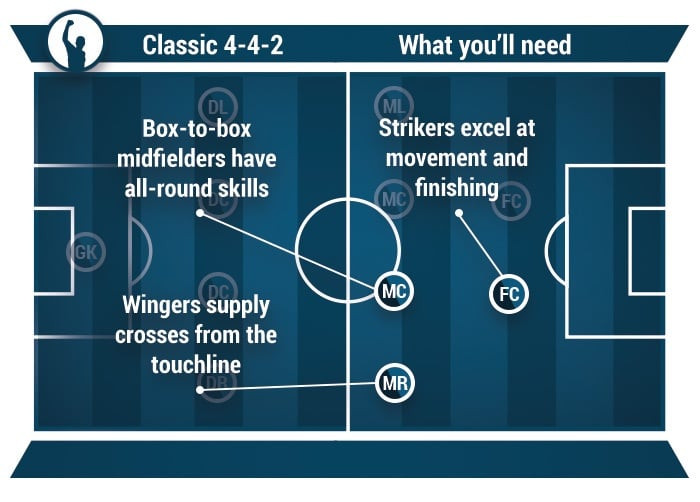 how to play classic 4-4-2 in football
how to play classic 4-4-2 in football
 classic 4-4-2 example Manchester United
classic 4-4-2 example Manchester United
2. Tiki-Taka
Tiki-Taka football gained prominence over the last decade, adopted by teams like Barcelona and Spain, leading to numerous league titles, European cups, and international tournament victories. This style is defined by short, intricate passing and fluid movement.
The success of Tiki-Taka lies in overloading the midfield with technically gifted players who can maintain possession for extended periods. This strategy requires intelligent and agile attackers who can create space and disrupt the opposition’s formation.
Tiki-Taka operates on the principle that the opposition cannot score if they don’t have the ball. The strategy involves maintaining possession for 60-70% of the game, controlling the pace of play and wearing down the opponent.
It’s difficult to assign a specific formation to the Tiki-Taka system, as its core is fluidity. However, a holding midfield player is essential, allowing the more creative midfielders to focus on creating scoring opportunities.
The space available for these midfielders is expanded by the full-backs, who frequently move forward to join the attack. This tactic was evident in Euro 2008, where players like Sergio Ramos and Juan Capdevilla advanced to disrupt the opposition’s midfield and provide outlets for players in possession.
Tiki-Taka has declined in popularity as teams have found success in pressing the team in possession or launching counter-attacks.
The common response to Tiki-Taka is to sit back, allowing the opposition to play in front while remaining compact to neutralize threats in the final third. When possession is regained, teams can exploit the high line maintained by the Tiki-Taka team.
While Tiki-Taka has become more direct due to these weaknesses, it has revolutionized the sport, making it more aesthetically pleasing.
 how to play tiki-taka in football
how to play tiki-taka in football
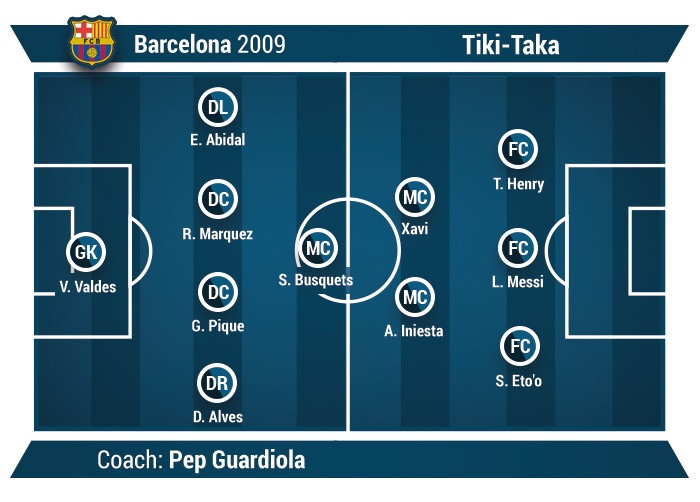 Tiki-Taka example Barcelona
Tiki-Taka example Barcelona
3. The Counter-Attack
As Tiki-Taka’s influence waned, the counter-attack emerged as a devastating tactic. It involves drawing the opposition into your defensive third, then launching a rapid attack upon regaining possession.
The counter-attack involves playing defensively, allowing the opposition to advance and commit players forward, which creates gaps. The objective is to win the ball and exploit these gaps to quickly attack and score.
Counter-attacking teams are typically divided into defensive and attacking units. The defensive unit sits deep, intercepting loose balls to regain possession. They then quickly pass the ball to the attacking unit, composed of fast and skillful players capable of exploiting space and creating one-on-one opportunities.
The essence of the counter-attack is speed in transitioning the ball forward. The attacking players must be better than the opposing defenders and be able to exploit available space before the opposition can reorganize.
Without the necessary components, the counter-attack can be risky, especially when used from the start of a match. It’s also effective when leading, as the opposition will commit more players forward in search of an equalizer, creating more space for counter-attacks.
Leicester City’s 2015/16 Premier League title-winning team and Real Madrid’s 2014 Champions League-winning side are excellent examples of counter-attacking teams. Real Madrid, with players like Gareth Bale and Cristiano Ronaldo, and playmakers like Xabi Alonso and Luka Modric, used the counter-attack to defeat Bayern Munich 4-0 on their path to European success.
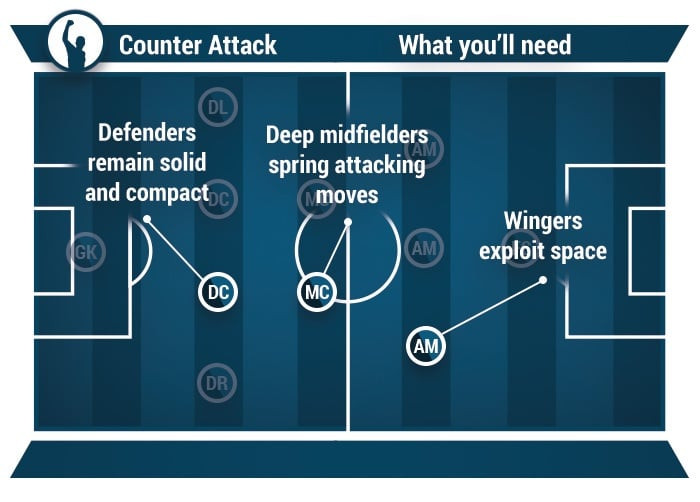 how to play counter-attack in football
how to play counter-attack in football
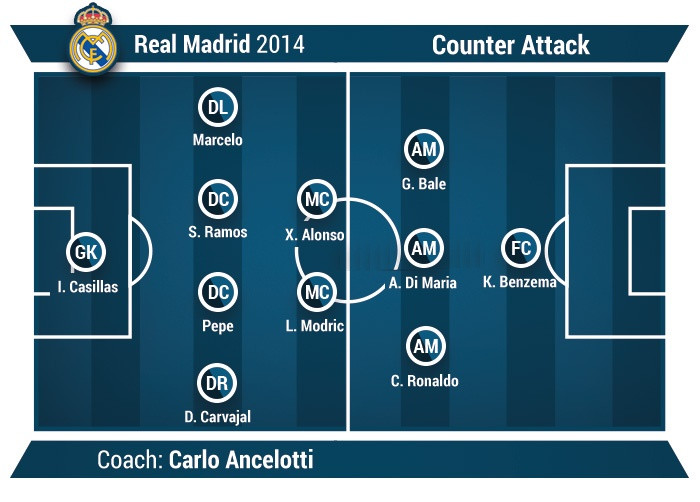 counter attack example in football Real Madrid
counter attack example in football Real Madrid
4. Park the Bus
The term “park the bus” was popularized by Jose Mourinho to describe a defensive strategy aimed at preventing the opposition from scoring.
Parking the bus involves prioritizing defense over attack, frustrating the opposition, and maintaining a clean sheet. A 0-0 draw is an acceptable outcome.
The 4-5-1 formation is often used when parking the bus, providing two defensive lines of four players each, with one player pressing the opposition in deeper positions. This formation can shift to a 6-4 when defending near the goal, with wingers acting as additional full-backs and the striker joining the midfield.
The defensive nature of this tactic gives it its name, implying an impenetrable wall in front of the goal. Success requires a disciplined team willing to fight for every ball. While effective at shutting down the opposition, this tactic often results in fewer wins due to a lack of attacking commitment.
Tony Pulis, as manager of Stoke City from 2008 to 2013, was known for employing this strategy, often playing for a draw in away matches. However, it is typically used in specific games rather than throughout an entire season, particularly against teams with superior attacking capabilities. Mourinho himself used this tactic by fielding no recognized striker in a game against Manchester United in 2013.
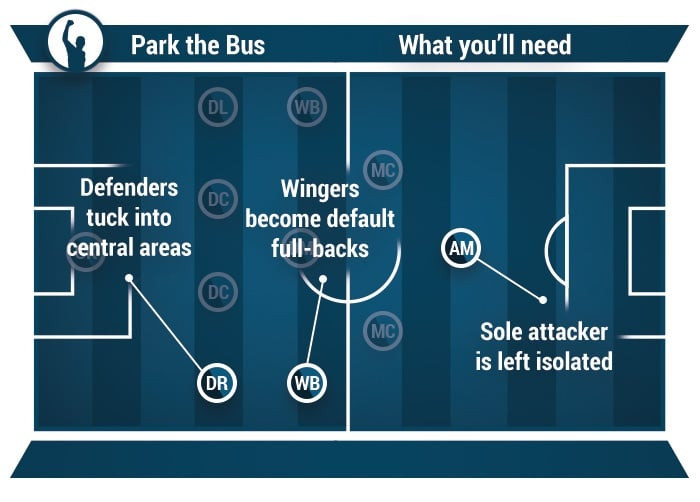 how to play park the bus in football
how to play park the bus in football
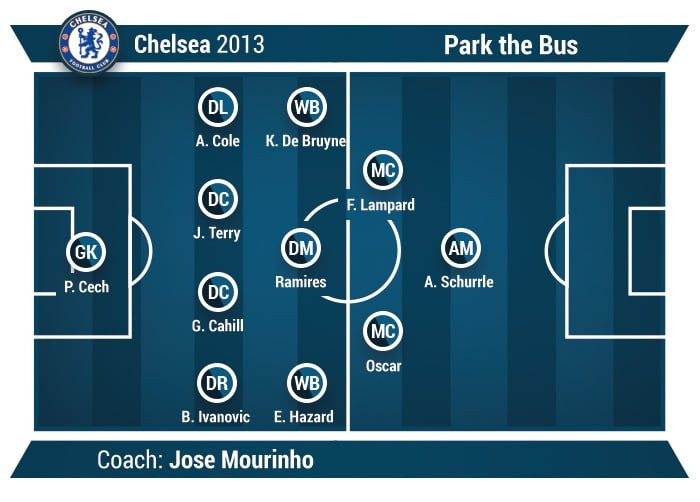 park the bus chelsea fc example
park the bus chelsea fc example
5. The Long Ball Game
The long ball game involves sending the ball forward from deep positions, often in the air, towards a striker who can secure the ball and initiate an attack.
To play this tactic effectively, forward players must be strong, capable of holding up the ball, and skilled in the air. The long ball can also be used to play the ball into space for a fast attacker. Additionally, the team needs attacking midfielders who can join the attack and support the striker.
Long ball teams typically adopt a defensive approach, prioritizing getting the ball as far away from their own goal as possible.
Although often criticized for being “ugly”, the long ball can lead to moments of brilliance. Dennis Bergkamp’s goal for Holland against Argentina in the 1998 World Cup is a prime example, initiated by a long ball from Frank de Boer that bypassed seven Argentine players.
Sam Allardyce is a well-known proponent of the long ball strategy. During his tenure at Bolton Wanderers from 1999 to 2007, he built a successful team around physical players like Kevin Davies and Kevin Nolan.
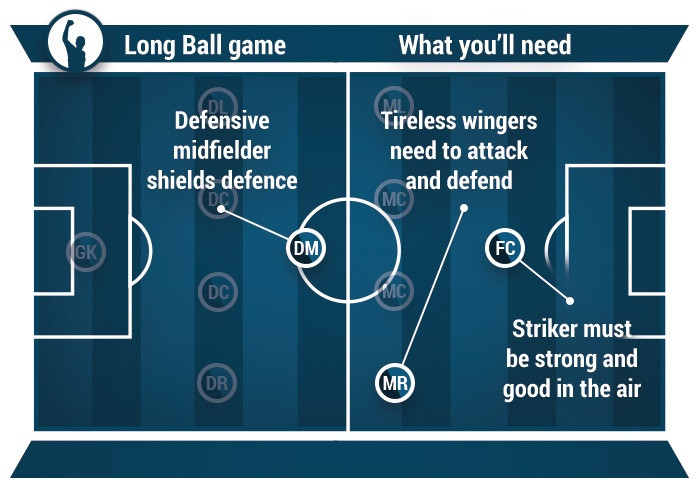 how to play high press in football
how to play high press in football
 long ball game football example Bolton Wanderers
long ball game football example Bolton Wanderers
6. The High Press
The high press is a tactic based on off-the-ball play. It assumes that winning the ball higher up the pitch reduces the distance to the goal.
This tactic involves a high defensive line, with all ten outfield players pressuring the opposition in possession. Unlike other tactics that allow the opposition possession in their own half, the high press involves harassing the opposition regardless of where the ball is.
The high press can be effective against possession-based teams by putting pressure on every pass. One mistake can quickly lead to an advanced position with attacking players already up the pitch.
Success requires all ten outfield players to press as a unit. It is a demanding tactic, requiring constant effort, but the rewards can be significant. Defending starts at the top, so a striker who is unselfish, mobile, and physically engaged is essential.
Long ball teams can counter the high press by lifting long balls over the defensive line. Fast players running into these spaces can bypass the entire press, exposing the space behind the team.
Jürgen Klopp’s Liverpool team exemplifies the high press. Klopp’s success with this tactic began during his time as Borussia Dortmund coach, leading the team to the Champions League final in 2012.
 how to play high press in football
how to play high press in football
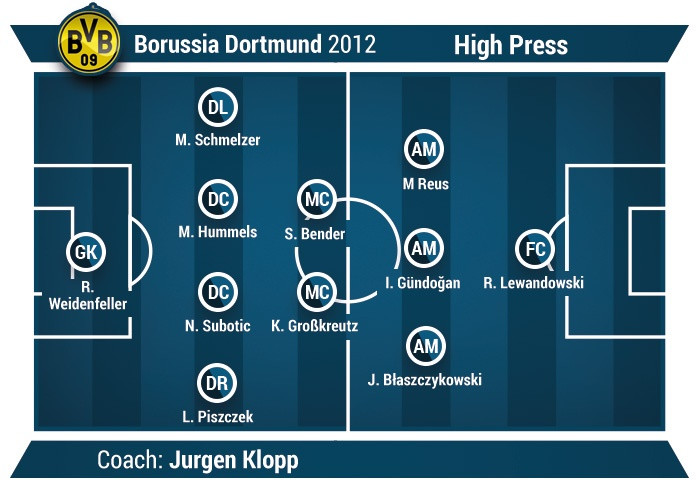 borussia dortmund example of high press football
borussia dortmund example of high press football
FAQ About Football Tactics
Q1: What is a formation in football?
A1: A formation is the arrangement of players on the field, defining their roles and positions.
Q2: What is a tactic in football?
A2: A tactic is a specific strategy or plan used during a match to achieve a particular goal, such as scoring or defending.
Q3: What is the most popular formation in modern football?
A3: The 4-3-3 is a popular formation, known for its balance between attack and defense.
Q4: What is the Tiki-Taka style of play?
A4: Tiki-Taka is a style characterized by short, intricate passing and fluid movement, aimed at maintaining possession and controlling the game.
Q5: What is a counter-attack?
A5: A counter-attack is a tactic where a team quickly transitions from defense to attack, exploiting the opposition’s exposed positions.
Q6: What does it mean to “park the bus”?
A6: “Parking the bus” is a defensive tactic where a team prioritizes preventing the opposition from scoring, often using a packed defense.
Q7: What is the long ball game?
A7: The long ball game involves sending the ball forward from deep positions, often in the air, towards a striker or into open space.
Q8: What is high pressing?
A8: High pressing is a tactic where a team aggressively pressures the opposition high up the pitch to win back possession quickly.
Q9: Why are tactics important in football?
A9: Tactics are important because they provide a structured approach to the game, helping teams maximize their strengths and exploit their opponents’ weaknesses.
Q10: How do managers choose which tactics to use?
A10: Managers consider various factors, including the strengths and weaknesses of their own team, the opposition’s style of play, and the overall game strategy.
Understanding the nuances of football tactics can significantly enhance your appreciation of the game. Whether you are a coach, player, or fan, grasping these strategies can provide deeper insights into the beautiful game.
For more in-depth analysis and answers to your questions, visit CauHoi2025.UK.COM. Need expert advice? Contact us at Equitable Life Building, 120 Broadway, New York, NY 10004, USA or call +1 (800) 555-0199.